For over fifty years, Kamen Rider has been that dude—no matter the mask, no matter the era. As an “anime guy,” I knew he had hands through cultural osmosis. But I hadn’t actually stepped into any of its series trenches until I came across a TikTok clip of him dismantling a villain from ass to appetite with such violent poetry, I binged the whole show just to understand the lore behind the mauling.
@ceedubelu Can't tiptoe around evil anymore. #christianhiphop #tokusatsu #dmvartist × × × Video: Kamen Rider Kuuga - ep.35 "Emotion"
♬ cross by CeeDubelu - ceedubelu
While sentai teams (like Power Rangers) fight in coordinated color-coded squads, Kamen Rider has been charging in solo (or sometimes with a partner), defending humanity one high-impact transformation at a time. His design usually draws on grasshopper or beetle motifs, and his powers vary greatly. But his essentials are a sleek motorcycle, a righteous leaping kick, choreographed poses, and enough campy flair to rouse kids from their slumber and watch on a Saturday morning. In short, Kamen Rider is the tokusatsu equivalent of Doctor Who, with generations of different Riders, crossover events, and legacy returns spanning its 40+ mainline series.
Figuring out “where to start” with a series like Kamen Rider is a frequently asked question for a series with a history spanning decades. For me, seeing the TikTok clip felt like the digital clouds parting and a message from internet heaven declaring that 2001’s Kamen Rider Kuuga was my first entry into the series.
Kamen Rider Kuuga is notable for being the series’ first widescreen broadcast version (despite being cropped during its original airing). It’s also the only one I’ve encountered over years of lurking that has a tone similar to Hideaki Anno’s darker, bloodier 2023 Shin Kamen Rider film (the best in his trilogy).
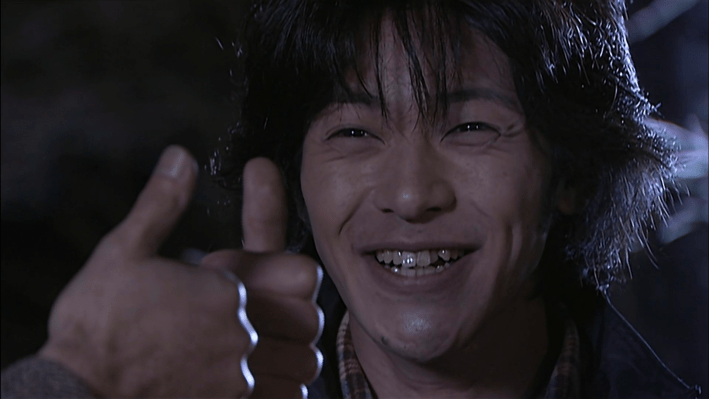
Kuuga follows hero Yusuke Godai. Yusuke is brave, great with kids, and has an infectious can-do attitude. No matter how bad things get, Yusuke radiates optimism and throws a thumbs-up to reassure friends and strangers that everything will be okay. After stumbling into an ancient curse, Yusuke becomes humanity’s last line of defense against the Gurongi—a tribe of ritualistic killers whose murders baffle the grim-faced cops trailing in their wake. His sunny disposition clashes with the show’s blood-soaked tone, making every act of heroism feel like a defiant act against despair.
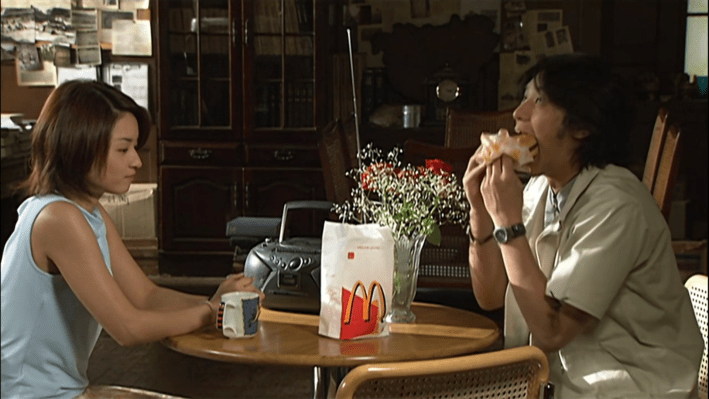
Each episode kicks off with a charming PSA reminding viewers to sit back and watch safely. Then it dives into the grim stuff: Yusuke Godai and Kaoru Ichijo, a no-nonsense cop, team up to thwart the Gurongi. Some Gurongi kill at random. Others treat murder like a twisted art project. Deadass, one villain was targeting people at swimming pool centers whose names matched notes from Chopin’s “Revolutionary Étude.” I couldn’t crack the case like Ichijo and Yusuke, but I respected the show for preluding its horror show at the pool by having its Sadako-coded Gurongi grimace at dancers vibing to LL Cool J’s “Around the Way Girl.” Every so often, Yusuke’s Kuuga powers evolve, unlocking new color-coded forms tailored to match the escalating threat level. Meanwhile, the Gurongi treat murder like a sport, tracking their kills on cursed jewelry or a demonic Etch-A-Sketch.
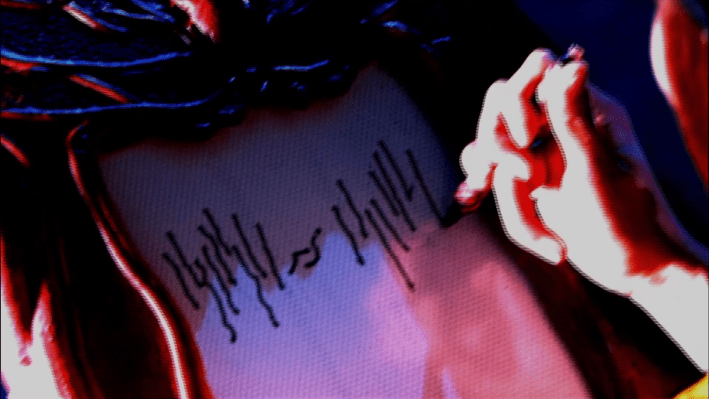
Kuuga usually appears as a last-minute savior. But don’t let the campy, bug-eyed look of his get-up deceive you. This show is filled with scenes so gruesome that, at times, they could easily belong in a Takashi Miike film, with their cruel and genuinely unsettling nature. So when Kuuga finally arrives, performing impromptu motocross stunts off Gurongi skulls or rider-kicking them into oblivion, it always feels well-earned.
While watching the show’s villain-of-the-week format evolve into something darker and more layered, I kept trying to guess which Gurongi would be the one to get World Starred into oblivion. I figured it had to be personal—maybe they hurt Oyassan, Yusuke’s warm, goofy café boss. Or perhaps they crossed the line with Ichijo, his emotionally repressed maybe-lover. But I was wrong. The villain fucked up by going after innocent children. It was at that moment Kuuga stopped being a hero and became a reckoning.
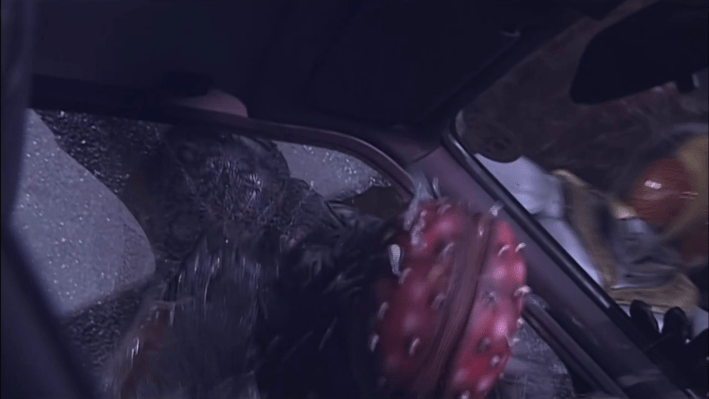
Spoilers for that
In the 34th episode, Kuuga contends with Jalaji—a real piece of shit’s piece of shit. Among the Gurongi, Jalaji is an outcast. His sick puppy modus operandi is targeting young high school boys for his serial killings. His method is cruelly precise: he fires a jagged metal shard into a child’s skull, then calmly informs them they have four days before it triggers a fatal stroke. As if that weren’t horrific enough, he stalks his next victim at the funerals of his last—creating a vicious cycle of grief and dread that feeds on itself like an ouroboros of terror.
“The more they suffer, the more fun it is.”
By the time Yusuke is alerted to Jalaji, he has already killed 85 teenagers, with his last victim committing suicide out of terror. After thwarting him once, Jalaji infiltrates the police-surveilled hospital of his latest victim, jauntily snapping his fingers down the hallway all the while. Yusuke, not having any of it, forgoes the pomp of his Kamen Rider transformation—something the show has called attention to with villains wising up to his wind-up time—and waves his hand mid-run and tackles him out of the three-story window. Now, finally, the generational ass whooping is upon us.
After tossing Jalaji out the window, Kuuga proceeds to beat Jalaji’s face into a bloody pulp without his usual electric guitar hero music underscoring the moment. When Jalaji tries to run away, Kuuga pulls him back for more. Hilariously, the fight is contrasted with Yusuke advising kindergarteners to use their words to resolve conflicts in the very episode. Meanwhile, Kuuga is giving a master class on how to handle Jalaji.
After a gnarly uppercut, Kuuga punches some numbers into his new motorcycle's keypad, revs it up, and runs over Jalaji, driving him to the countryside. Jalaji, thinking he’s slick, tries to stab Kuuga. But Kuuga, cold as hell, transforms into his powerful purple form without any fanfare, swats his knife away, and brakes hard, sending Jalaji into the shore. Without wasting a second, Kuuga transforms the handlebars of his cycle into a sword and approaches Gurongi like the goddamn Terminator, shrugging off more needles, and proceeds to posterize Jalaji with slashes before plunging his sword into his chest until he’s engulfed in flames.
The following episode doesn’t even bother to consider how vicious and villainous Kuuga’s beating of Jalaji was, with some “don’t stoop to their level” cliché virtue signaling nonsense. Kuuga was justified, and the show moved on, as it should.
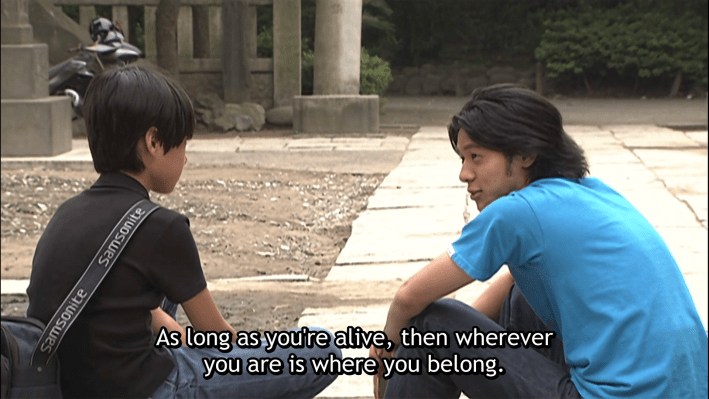
Out of context, this one-sided fight easily ranks among the most legendary beatdowns in sentai and tokusatsu history. However, within the show’s framework, it hits harder—revealing a deeper, surprisingly anti-shonen thread that is woven through Kamen Rider Kuuga. As Yusuke levels up, his powers grow more volatile, his body barely keeping pace with his transformations. The police grow uneasy, sensing that their hero might be burning out under the pressure to save the day from Gurongi and their own ineptitude, dispatch with them. Yusuke keeps smiling, keeps saying “everything will be fine,” but in rare quiet moments, soft-spoken doubts hang over him where he voices his own hope that the fighting will end soon.
Beneath the rubber suits and bold kicks, Kamen Rider Kuuga battles real-world anxieties: the fear of raising children in a violent world and the toll of burdening stalwart heroes. Still, every time Kuuga appears to knock out a villain into explosion.mp4, it feels like a massive, cathartic victory. Not as gratifying as Jalaji’s defeat, but it’s a reminder that even amid chaos, someone is still fighting to make things right—even if it means ulting on a villain who was a thousand years too early to catch the smoke.


